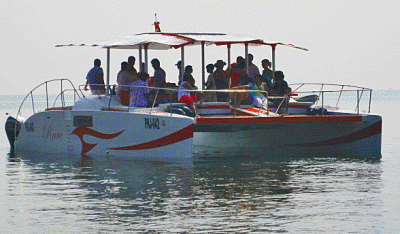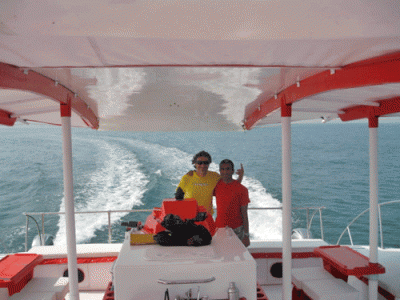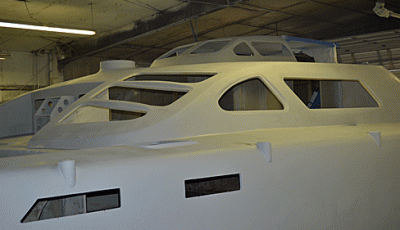Realized today that I really miss not having Murray-Pacific Salvage and Boeing Surplus around. Are there any replacement salvage places to any degree that anyone knows about?
More From Goa
The 32′ daycharter power cat from Goa is in use there now. More details soon. Design was a joint venture with Maneck the builder.
20+ knots with a pair of 40 hp short shafts.
and a video. It needs a soundtrack by Badmarsh.
Alex’s Cat Picture
I got to visit Alex’s 45′ KHSD catamaran as it was being primed. Notice the holder for the mast bearings. It will have aeroesque unstayed carbon fiber mast. No smell at all from the paint being sprayed. I understand it will be pushed out the door as soon as the topcoat goes on. Should be much better pictures then. Notice also the stanchion bases. Very nice.
Water Based Primer
I got to visit Alex’s 45′ catamaran project yesterday in Bellingham. It was being spray painted with water based primer. System 3 WR-155 Epoxy Primer. http://www.jamestowndistributors.com/userportal/show_product.do?pid=71&familyName=System+Three+WR-155+Epoxy+Primer
I had forgotten that it is possible to do high-test spray painting without scaring the neighbors with the lethal stink. Pictures soon.
Server Down Again
It seems it was time for my ISP, Drizzle to go dark again. I see that I have no website and no email today. I think it does indeed work better in Uganda than at Drizzle. If it weren’t for Jesus, their amazing tech guy, I would be gone.
So, alternate email if needed. themultihulldesigns@gmail.com
they fixed it for now.
House Foam on Multihulls
I am often asked if house insulation foam can be used on boats. A few years ago I would have declared “never”. Since I have been building my own SIP panels on the lunar lander project, I have moderated a bit. But only on non structural items. I used the Foamular pink foam to vacuum bag panels. http://www.foamular.com/foam/
It ranges in density from 15 psi compression strength up to 40 psi or even 60 psi compression strength. I assume the shear strength is similar. I don’t see weights listed but it is light. One downside is there are no thicknesses of less than 1″ available. It can be gotten at Home Depot or any other similar store. If vacuum bagged with thin plywood faces, (3mm or even 2mm) it can make very light and inexpensive cored flats for your multi interior. The edges will be much easier to smooth than any of the honeycomb or Nida products.
Another Goa Picture
Fiberlay Class, Portland
Just notified about a Fiberlay composites and molding class in Portland, OR on December 1. The PDF below is a little large. Sorry. Am trying to get them to hire a blog geek for things like this.
http://web.fiberlay.com/emailblast/TrainingClasses-12-1-12.pdf
Basalt Fabric Composites
Some 8 years or so ago my friend, entrepreneur and crazed genius inventor, Chippy, showed me some basalt fiberglass fabric. He declared that it had better properties than glass at a fraction of the cost. I understand that the factory burned down and I forgot about it.
Last week I got to meet Mike and Jenn building a cat in Portland, OR. Mike helps build wind generators. They are looking into basalt fabric. I include these links which I have not yet had time to explore. So.
http://www.basaltfm.com/eng/fiber/info.html
http://www.sudaglass.com/chars.html
http://www.basfiber.com/roving
“Check it out. My snowboard has this instead of carbon for stiffness. It is made by Lib Technologies.
http://www.lib-tech.com/technology/basalt/
I have found references that it is 1/4 the cost of Carbon. Though I have not contacted suppliers. I’ll see if this is true.
Other advantages~
Higher UV and heat resistance than carbon
RF Transparent (Military might like this)
non-conductive!!! (better to protect against lightning damage)
environmentally friendly, greenhouse gases released long ago from natural process” Mike
Ending the Fax
I realized that except for the spam faxes, I have not gotten a work related fax in over a year. It must be a sign of the times. Its all the web and email now.
I am dropping that line and the fax number, 206-283-4106.



